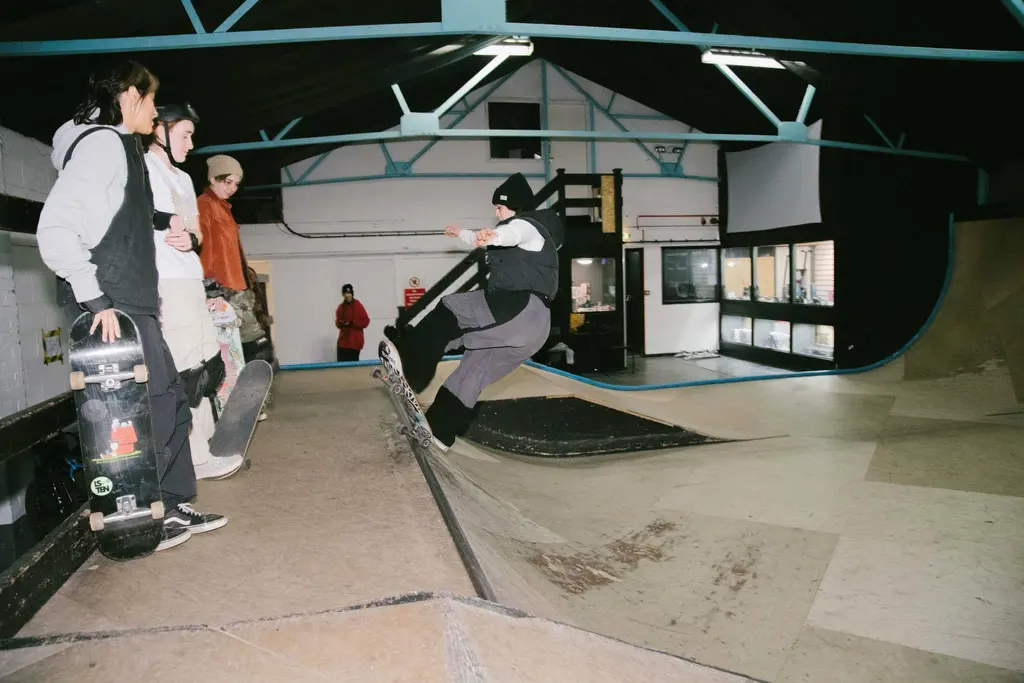Joe Lauder, Satta
- Text by D'Arcy Doran
- Photography by Photo Adrian Morris, Video Ed Andrews

Joe Lauder once spent a month living with a shaman in the Amazon. Ever since, nature has been the inspiration behind all of his work, whether he’s crafting a skateboard, a bookcase or a garden. For Huck’s Show Your Work series, Joe let us look over his shoulder and into his sketchbook to show where his ideas begin.
The series is inspired by Austin Kleon’s book Show Your Work! and aims to showcase the process behind work being produced by members of Huck’s community. We want you to get involved. If you would like to be featured, post a process pic or two on Twitter, Facebook, Instagram or Google+ with the hashtag #huckprocess.
Joe Lauder, Satta
What role does sketching play in your work?
Everything starts with a sketch, from designing furniture, a garden… a skateboard shape, or an illustration. The sketch is the first time it’s brought out from an idea floating around my head to an image that can be understood a million times better than talking about it. I’ve got a bad habit, when anyone starts trying to describe something to me, I always shove a pen in their hand and tell them to draw it. I learnt it from a tutor who always did it to me, but I think as a designer its vital to be able to quickly give a visual representation of your ideas.
Is there a particular technique you’re trying to learn, or challenge you’re trying to overcome?
I guess just appreciating the nature of things as they are with a directness and without being self-conscious. In any creative work, I make my best effort to remove myself and allow the work to spring forth from a kind of meditative state, unbound by struggle, or preoccupations with how I want to be perceived.
There’s a Japanese concept “Wabi-Sabi” that encapsulates it perfectly, really. Wabi comes from the root “wa” which has come to mean simple, unmaterialistic, humble by choice, and in tune with nature. Sabi means “the blooming of time,” which arises from observing the impermanence of beauty.
So the technique I’m trying to learn? To see things as they are and reflect that. The challenge I’m trying to overcome? Myself!
What environment do you work best in?
My working environment is my live-work studio. It’s basically a wood workshop with a bed in one corner and a desk and studio space in another corner. Music plays a big part in giving me a rhythm to work to. More important for me than music I think is smell. It’s always been really important to me. Incense is a must. Routine wise, I usually get up between 5-6 am every day. In the morning, my mind feels clear and sharp. By about 2 pm the day feels like it’s done for me in terms of productivity.
Is there a place you like to go for inspiration?
I’d say that 90% of anything I do is inspired by my travels. When you travel, you get to shed the skin you’ve built up around you back home. What I mean by that is: You’re away from your stuff, and your people, you have no home, you’re an outsider. You start to live in an in-between space, unbound by your own culture, and the familiarities of your day to day life. You start to familiarise yourself with natural patterns — the rising and setting of the sun, the changing moons, new landscapes, new smells, new peoples. It’s just you and the natural environment you’re in at the time. For me, that’s the best place for inspiration to sprout.
What the best advice anyone ever gave you about getting things done?
“Just do it.” — author unknown.
Watch Huck’s Satta Skates video, read Huck’s profile of Joe Lauder and you can check out his hand made creations at Satta.
If you would like to be featured on Show Your Work, post a process pic or two on Twitter, Instagram, Facebook or Google+ along with the hashtag #huckprocess.
Latest on Huck

Clubbing is good for your health, according to neuroscientists
We Become One — A new documentary explores the positive effects that dance music and shared musical experiences can have on the human brain.
Written by: Zahra Onsori

In England’s rural north, skateboarding is femme
Zine scene — A new project from visual artist Juliet Klottrup, ‘Skate Like a Lass’, spotlights the FLINTA+ collectives who are redefining what it means to be a skater.
Written by: Zahra Onsori

Donald Trump says that “everything is computer” – does he have a point?
Huck’s March dispatch — As AI creeps increasingly into our daily lives and our attention spans are lost to social media content, newsletter columnist Emma Garland unpicks the US President’s eyebrow-raising turn of phrase at a White House car show.
Written by: Emma Garland

How the ’70s radicalised the landscape of photography
The ’70s Lens — Half a century ago, visionary photographers including Nan Goldin, Joel Meyerowitz and Larry Sultan pushed the envelope of what was possible in image-making, blurring the boundaries between high and low art. A new exhibition revisits the era.
Written by: Miss Rosen

The inner-city riding club serving Newcastle’s youth
Stepney Western — Harry Lawson’s new experimental documentary sets up a Western film in the English North East, by focusing on a stables that also functions as a charity for disadvantaged young people.
Written by: Isaac Muk

The British intimacy of ‘the afters’
Not Going Home — In 1998, photographer Mischa Haller travelled to nightclubs just as their doors were shutting and dancers streamed out onto the streets, capturing the country’s partying youth in the early morning haze.
Written by: Ella Glossop